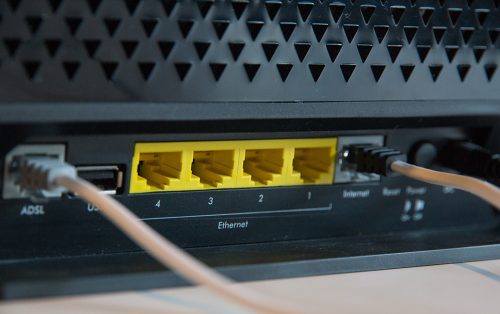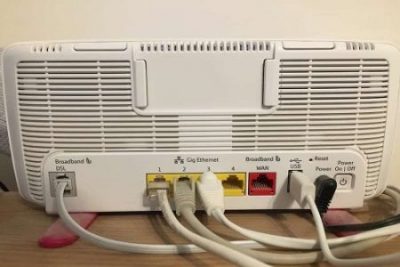Affiliate Disclosure: As an Amazon Associate I earn from qualifying purchases.
If you look at the back of your router, you will see a port labeled “WAN”. Sometimes this can have a cable plugged into it, whereas in some cases it is left empty. So, what is the purpose of this WAN port and what is it used for?
The WAN port on your router is the uplink to the Internet. It is used to connect to your modem which in turn allows you to connect to the Internet. Unless you access the Internet via a telephone link, without a WAN connection there will be no Internet connectivity.
What Is the Difference Between LAN and WAN?
LAN and WAN ports are found on the back of your router, so it is important to know the difference between the two so you can plug the correct cables into the correct ports.
On a typical router, you will see usually four LAN marked ports and one WAN marked port, although without these labels the ports will look identical unless they are colored differently.
Let’s discuss LAN first.
LAN is the abbreviation for Local Area Network and is essentially a group of devices connected to each other over your home network. In your home, every device connected to the Internet via your router is part of your LAN.
Devices connected over a LAN allow the sharing of resources such as files or printers, but also allow connectivity to each other. A good example of this is having a networked printer connected to your LAN which allows any of your print-enabled devices to print directly to it.
Ask your neighbor to print to it, however, and they will quickly find they are unable to do so due to not being connected to your LAN.
Unless you decided to share your Wi-Fi password with them, of course.
On the other hand, we have WAN, which stands for Wide Area Network.
WANs are a little bit more complicated in that they can be both private or public, but are easy to understand when you think of a few examples.
A good way to understand how a private WAN works would be to think of a large corporation with many offices spread out from each other.
Each office is likely to have it’s own dedicated LAN to connect all of its local devices and resources together. The WAN comes in to connect all of the individual office’s LANs together, allowing everyone in the company to access each office’s resources.
As a side note, as a WAN connects LANs together over the Internet, safeguards need to be put in place by corporations to prevent any unauthorized access to their networks.
This is where a VPN tunnel will be used. When a VPN (Virtual Private Network) is configured at each office, a secure tunnel is established where all traffic passes through is used, making it private and inaccessible to unauthorized individuals.
For you at home, though, WAN is nowhere near as complicated as this and is simply a way for your router to be able to access the Internet and share the connectivity with the devices connected to it.
Your Internet Service Provider will connect your LAN to their WAN, giving you Internet access.
This applies to all of the ISP’s customers, but for reassurance, your ISP will not join your LAN with anyone else’s; they are kept separate.

What about WLAN?
WLAN is a term that gets thrown around with LAN and WAN.
You now know that WAN stands for Wide Area Network, but a common misconception is that it stands for Wireless Area Network.
Given that most people have been familiar with the term LAN for many years, it is understandable for the assumption to be that local is replaced with wireless.
WLAN stands for Wireless Local Area Network, but can often be referred to as a Wireless LAN. This is essentially a network that allows devices to communicate with each other wirelessly over Wi-Fi instead of a traditional LAN where the connectivity comes over Ethernet cable.
Here is a quick summary of a LAN, WAN, and WLAN as it is easy to get the three confused with each other.
| Term | Abbreviation | Description | Example |
| Local Area Network | LAN | Devices connected to a local network via a physical cable | An office |
| Wide Area Network | WAN | Connects multiple LANs together over the Internet | A companies’ data center |
| Wireless Local Area Network | WLAN | Devices connected to a local network via a wireless connection | A coffee shop’s public Wi-Fi |
What Is the Purpose of the DSL Port?
If you are quite happily reading this article on your computer at home yet notice there is no connection to your WAN port, your router has connectivity to the Internet by other means, which is likely to be via the DSL port.
Unlike the WAN port, the DSL port is for connection to a phone line which includes Internet services.
It really comes down to the type of home router you have. Some will have a modem built-in, whereas others won’t.
Those with a built-in modem will connect directly into the phone line via their DSL port, giving them Internet connectivity providing the Internet service on the phone line is active.
Routers without a built-in modem will need a separate modem in order for you to get access to the Internet, which is where the WAN port comes in; to establish a connection between the modem and the router.
Some routers will come with a built-in modem but also a WAN port. This gives you the flexibility to use the router with an external modem instead of the one built-in if you would prefer.
This is particularly useful if you change ISP in the future to one that requires a different modem, but you wish to continue using the same router.
You may also like: Do You Need a Router If You Have a Modem?
When to Not Use the WAN Port
If you are looking to connect a second router to your home network, it is important to not use the WAN port on the secondary router to connect it to the primary one as this will exclude it from your LAN.
You are introducing the second router into the already existing LAN, so a free LAN port should be used to establish connectivity between the two.
Why Does a Router Have More Than One WAN Ports?
It’s not particularly common, especially on routers that an ISP provides as part of their Internet package, however, some routers will come with two or sometimes even more WAN ports.
Multiple WAN ports can be used together to improve the robustness, and sometimes even performance, of the network.
If a router has dual WAN ports, it likely supports failover. This is where one WAN port is connected to one modem and is considered the primary. The second WAN port will be connected to a separate WAN connection and is used as a backup in the event of a failure on the primary line.
This setup is more commonly found in large corporations that can’t afford to have a single point of failure in regards to Internet connectivity, so probably isn’t really worth considering when building your home network.
Can the WAN Port Be Used as a LAN Port?
If the WAN port on your router is not being used, it begs the question as to whether it can be used as a LAN port to connect an additional device directly to the router instead, rather than being left empty and going to waste.
Although this would be useful, unfortunately, it is not possible. The ports do look identical but perform very different functions.
If you find the number of LAN ports on your router isn’t enough, you might want to consider investing in a switch. This will give you many additional LAN ports to connect your devices to your router.
Related article: How Many Network Switches Can Be Connected to a Router?
Conclusion
The WAN port on your router simply allows your home network access to the Internet providing it has connectivity to a functional modem. Often the WAN port is not used if you receive Internet services over a phone line, in which case the DSL port on the router is used instead.
